BUSN20016 Research: Teenage Entrepreneurship in Global Business
VerifiedAdded on 2023/03/31
|16
|3469
|370
Report
AI Summary
This research proposal investigates the role of teenage entrepreneurship in the global business world. It aims to analyze the enhancing factors and present trends of teenage entrepreneurship. The study justifies the need to adopt entrepreneurship among youth and identifies barriers to its adoption, offering valuable insights for policymakers, learning institutions, and the business world. The proposal covers teenage entrepreneurship trends, measurement of entrepreneurship and global business, positive factors influencing entrepreneurship, and hypothesis development. It outlines the research methodology, including data collection and analysis techniques, and provides a budget and project schedule. The research seeks to understand how teenage entrepreneurship can contribute to economic growth, innovation, and employment creation.
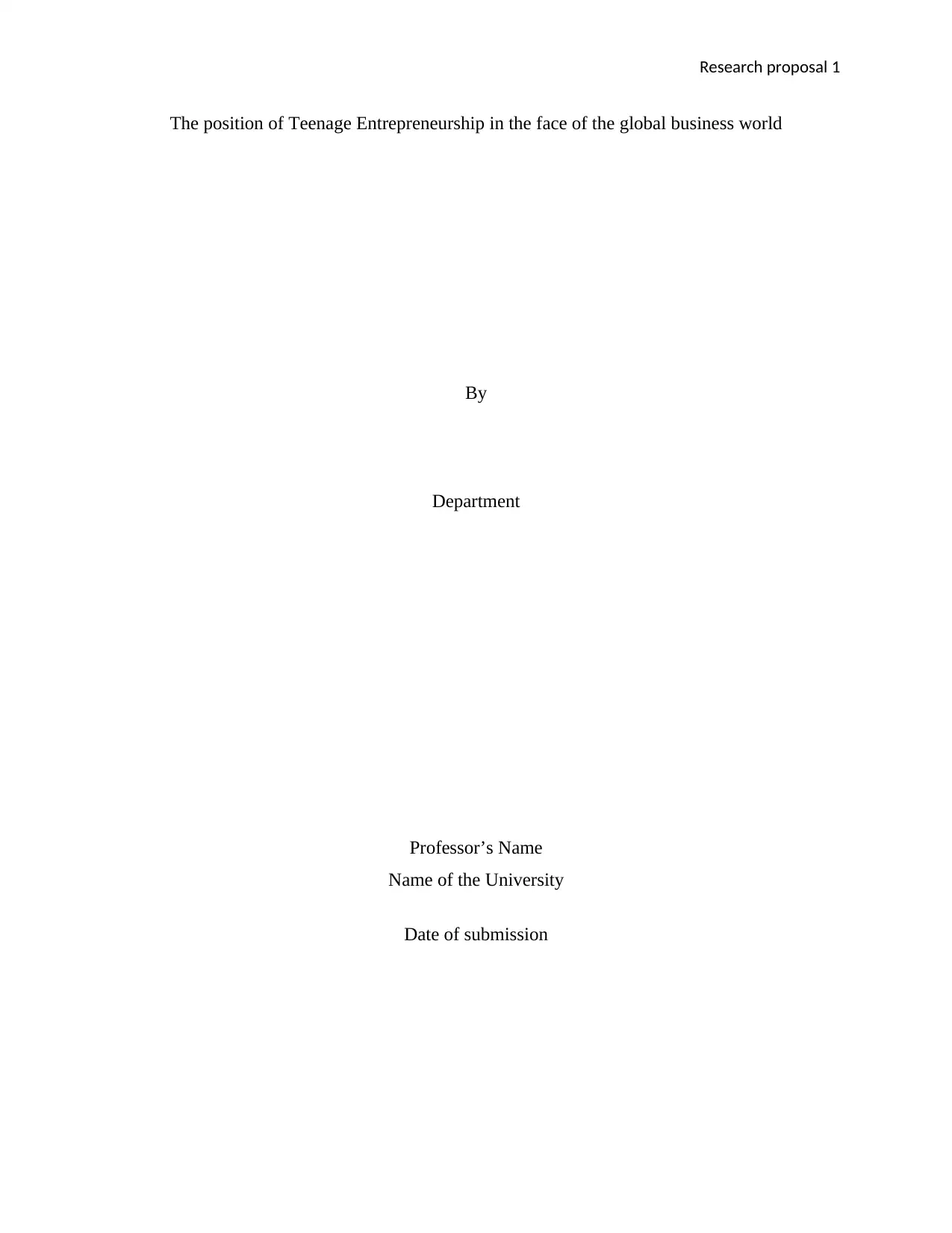
Research proposal 1
The position of Teenage Entrepreneurship in the face of the global business world
By
Department
Professor’s Name
Name of the University
Date of submission
The position of Teenage Entrepreneurship in the face of the global business world
By
Department
Professor’s Name
Name of the University
Date of submission
Paraphrase This Document
Need a fresh take? Get an instant paraphrase of this document with our AI Paraphraser
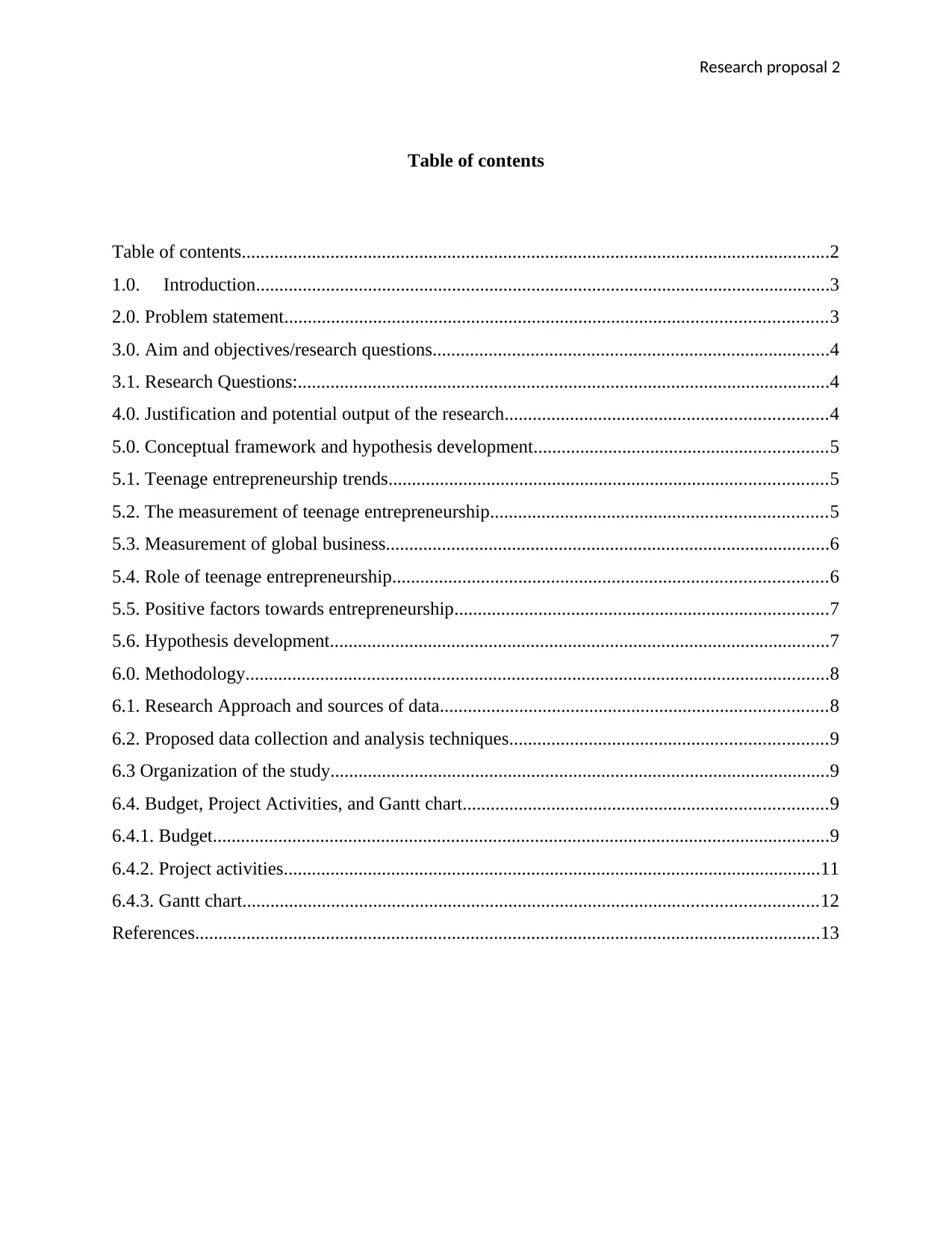
Research proposal 2
Table of contents
Table of contents..............................................................................................................................2
1.0. Introduction...........................................................................................................................3
2.0. Problem statement....................................................................................................................3
3.0. Aim and objectives/research questions.....................................................................................4
3.1. Research Questions:..................................................................................................................4
4.0. Justification and potential output of the research.....................................................................4
5.0. Conceptual framework and hypothesis development...............................................................5
5.1. Teenage entrepreneurship trends..............................................................................................5
5.2. The measurement of teenage entrepreneurship........................................................................5
5.3. Measurement of global business...............................................................................................6
5.4. Role of teenage entrepreneurship.............................................................................................6
5.5. Positive factors towards entrepreneurship................................................................................7
5.6. Hypothesis development...........................................................................................................7
6.0. Methodology.............................................................................................................................8
6.1. Research Approach and sources of data...................................................................................8
6.2. Proposed data collection and analysis techniques....................................................................9
6.3 Organization of the study...........................................................................................................9
6.4. Budget, Project Activities, and Gantt chart..............................................................................9
6.4.1. Budget....................................................................................................................................9
6.4.2. Project activities...................................................................................................................11
6.4.3. Gantt chart...........................................................................................................................12
References......................................................................................................................................13
Table of contents
Table of contents..............................................................................................................................2
1.0. Introduction...........................................................................................................................3
2.0. Problem statement....................................................................................................................3
3.0. Aim and objectives/research questions.....................................................................................4
3.1. Research Questions:..................................................................................................................4
4.0. Justification and potential output of the research.....................................................................4
5.0. Conceptual framework and hypothesis development...............................................................5
5.1. Teenage entrepreneurship trends..............................................................................................5
5.2. The measurement of teenage entrepreneurship........................................................................5
5.3. Measurement of global business...............................................................................................6
5.4. Role of teenage entrepreneurship.............................................................................................6
5.5. Positive factors towards entrepreneurship................................................................................7
5.6. Hypothesis development...........................................................................................................7
6.0. Methodology.............................................................................................................................8
6.1. Research Approach and sources of data...................................................................................8
6.2. Proposed data collection and analysis techniques....................................................................9
6.3 Organization of the study...........................................................................................................9
6.4. Budget, Project Activities, and Gantt chart..............................................................................9
6.4.1. Budget....................................................................................................................................9
6.4.2. Project activities...................................................................................................................11
6.4.3. Gantt chart...........................................................................................................................12
References......................................................................................................................................13
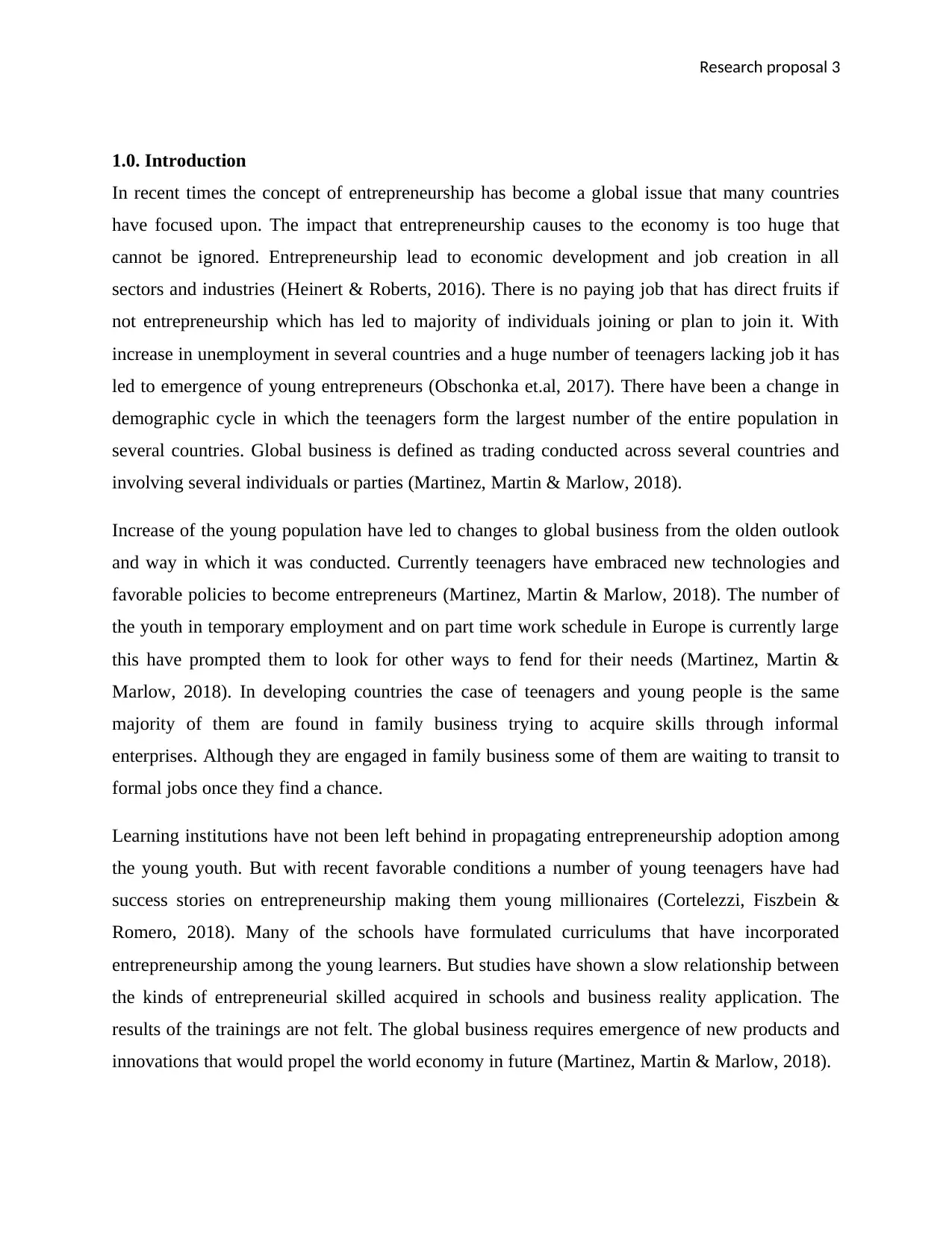
Research proposal 3
1.0. Introduction
In recent times the concept of entrepreneurship has become a global issue that many countries
have focused upon. The impact that entrepreneurship causes to the economy is too huge that
cannot be ignored. Entrepreneurship lead to economic development and job creation in all
sectors and industries (Heinert & Roberts, 2016). There is no paying job that has direct fruits if
not entrepreneurship which has led to majority of individuals joining or plan to join it. With
increase in unemployment in several countries and a huge number of teenagers lacking job it has
led to emergence of young entrepreneurs (Obschonka et.al, 2017). There have been a change in
demographic cycle in which the teenagers form the largest number of the entire population in
several countries. Global business is defined as trading conducted across several countries and
involving several individuals or parties (Martinez, Martin & Marlow, 2018).
Increase of the young population have led to changes to global business from the olden outlook
and way in which it was conducted. Currently teenagers have embraced new technologies and
favorable policies to become entrepreneurs (Martinez, Martin & Marlow, 2018). The number of
the youth in temporary employment and on part time work schedule in Europe is currently large
this have prompted them to look for other ways to fend for their needs (Martinez, Martin &
Marlow, 2018). In developing countries the case of teenagers and young people is the same
majority of them are found in family business trying to acquire skills through informal
enterprises. Although they are engaged in family business some of them are waiting to transit to
formal jobs once they find a chance.
Learning institutions have not been left behind in propagating entrepreneurship adoption among
the young youth. But with recent favorable conditions a number of young teenagers have had
success stories on entrepreneurship making them young millionaires (Cortelezzi, Fiszbein &
Romero, 2018). Many of the schools have formulated curriculums that have incorporated
entrepreneurship among the young learners. But studies have shown a slow relationship between
the kinds of entrepreneurial skilled acquired in schools and business reality application. The
results of the trainings are not felt. The global business requires emergence of new products and
innovations that would propel the world economy in future (Martinez, Martin & Marlow, 2018).
1.0. Introduction
In recent times the concept of entrepreneurship has become a global issue that many countries
have focused upon. The impact that entrepreneurship causes to the economy is too huge that
cannot be ignored. Entrepreneurship lead to economic development and job creation in all
sectors and industries (Heinert & Roberts, 2016). There is no paying job that has direct fruits if
not entrepreneurship which has led to majority of individuals joining or plan to join it. With
increase in unemployment in several countries and a huge number of teenagers lacking job it has
led to emergence of young entrepreneurs (Obschonka et.al, 2017). There have been a change in
demographic cycle in which the teenagers form the largest number of the entire population in
several countries. Global business is defined as trading conducted across several countries and
involving several individuals or parties (Martinez, Martin & Marlow, 2018).
Increase of the young population have led to changes to global business from the olden outlook
and way in which it was conducted. Currently teenagers have embraced new technologies and
favorable policies to become entrepreneurs (Martinez, Martin & Marlow, 2018). The number of
the youth in temporary employment and on part time work schedule in Europe is currently large
this have prompted them to look for other ways to fend for their needs (Martinez, Martin &
Marlow, 2018). In developing countries the case of teenagers and young people is the same
majority of them are found in family business trying to acquire skills through informal
enterprises. Although they are engaged in family business some of them are waiting to transit to
formal jobs once they find a chance.
Learning institutions have not been left behind in propagating entrepreneurship adoption among
the young youth. But with recent favorable conditions a number of young teenagers have had
success stories on entrepreneurship making them young millionaires (Cortelezzi, Fiszbein &
Romero, 2018). Many of the schools have formulated curriculums that have incorporated
entrepreneurship among the young learners. But studies have shown a slow relationship between
the kinds of entrepreneurial skilled acquired in schools and business reality application. The
results of the trainings are not felt. The global business requires emergence of new products and
innovations that would propel the world economy in future (Martinez, Martin & Marlow, 2018).
⊘ This is a preview!⊘
Do you want full access?
Subscribe today to unlock all pages.

Trusted by 1+ million students worldwide
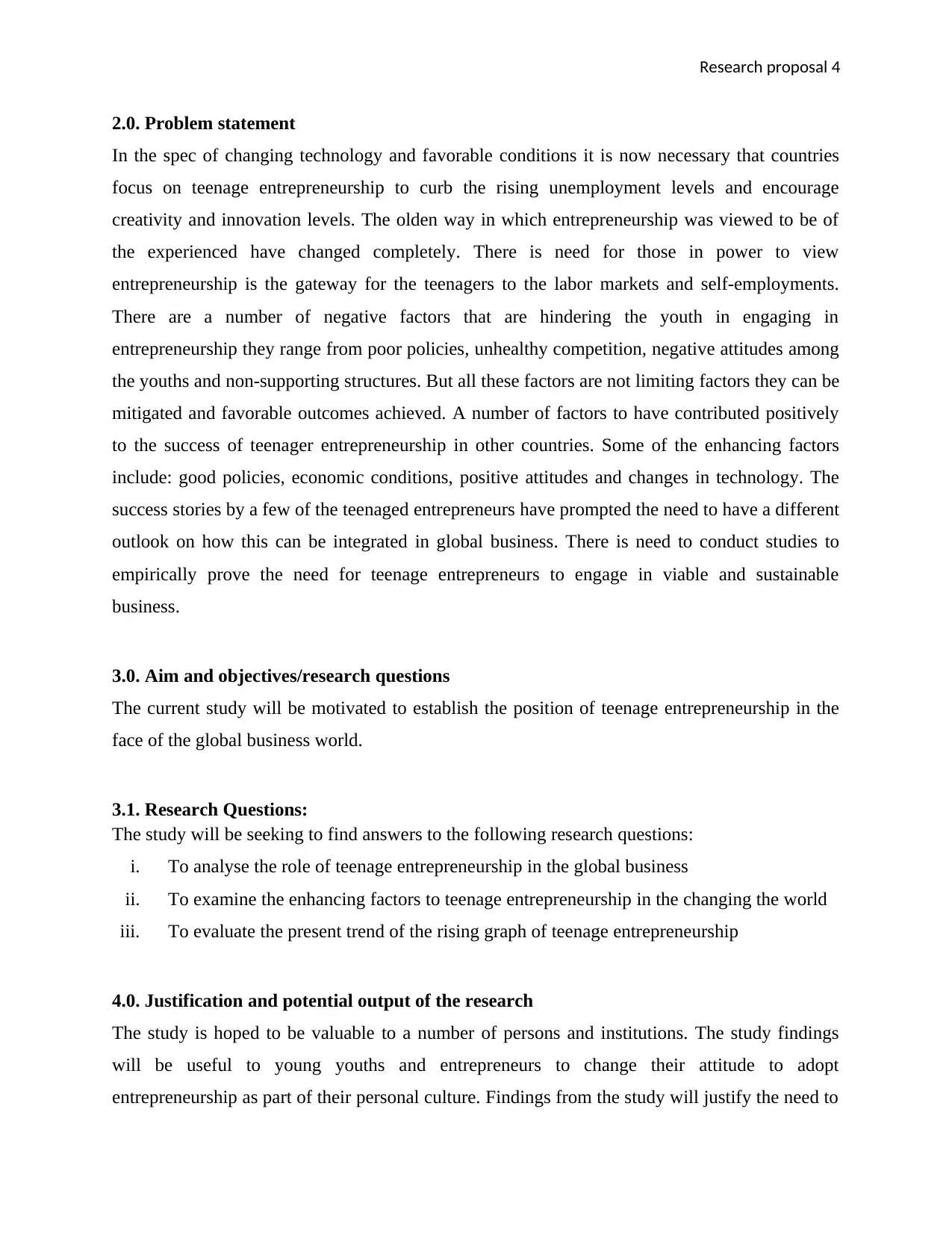
Research proposal 4
2.0. Problem statement
In the spec of changing technology and favorable conditions it is now necessary that countries
focus on teenage entrepreneurship to curb the rising unemployment levels and encourage
creativity and innovation levels. The olden way in which entrepreneurship was viewed to be of
the experienced have changed completely. There is need for those in power to view
entrepreneurship is the gateway for the teenagers to the labor markets and self-employments.
There are a number of negative factors that are hindering the youth in engaging in
entrepreneurship they range from poor policies, unhealthy competition, negative attitudes among
the youths and non-supporting structures. But all these factors are not limiting factors they can be
mitigated and favorable outcomes achieved. A number of factors to have contributed positively
to the success of teenager entrepreneurship in other countries. Some of the enhancing factors
include: good policies, economic conditions, positive attitudes and changes in technology. The
success stories by a few of the teenaged entrepreneurs have prompted the need to have a different
outlook on how this can be integrated in global business. There is need to conduct studies to
empirically prove the need for teenage entrepreneurs to engage in viable and sustainable
business.
3.0. Aim and objectives/research questions
The current study will be motivated to establish the position of teenage entrepreneurship in the
face of the global business world.
3.1. Research Questions:
The study will be seeking to find answers to the following research questions:
i. To analyse the role of teenage entrepreneurship in the global business
ii. To examine the enhancing factors to teenage entrepreneurship in the changing the world
iii. To evaluate the present trend of the rising graph of teenage entrepreneurship
4.0. Justification and potential output of the research
The study is hoped to be valuable to a number of persons and institutions. The study findings
will be useful to young youths and entrepreneurs to change their attitude to adopt
entrepreneurship as part of their personal culture. Findings from the study will justify the need to
2.0. Problem statement
In the spec of changing technology and favorable conditions it is now necessary that countries
focus on teenage entrepreneurship to curb the rising unemployment levels and encourage
creativity and innovation levels. The olden way in which entrepreneurship was viewed to be of
the experienced have changed completely. There is need for those in power to view
entrepreneurship is the gateway for the teenagers to the labor markets and self-employments.
There are a number of negative factors that are hindering the youth in engaging in
entrepreneurship they range from poor policies, unhealthy competition, negative attitudes among
the youths and non-supporting structures. But all these factors are not limiting factors they can be
mitigated and favorable outcomes achieved. A number of factors to have contributed positively
to the success of teenager entrepreneurship in other countries. Some of the enhancing factors
include: good policies, economic conditions, positive attitudes and changes in technology. The
success stories by a few of the teenaged entrepreneurs have prompted the need to have a different
outlook on how this can be integrated in global business. There is need to conduct studies to
empirically prove the need for teenage entrepreneurs to engage in viable and sustainable
business.
3.0. Aim and objectives/research questions
The current study will be motivated to establish the position of teenage entrepreneurship in the
face of the global business world.
3.1. Research Questions:
The study will be seeking to find answers to the following research questions:
i. To analyse the role of teenage entrepreneurship in the global business
ii. To examine the enhancing factors to teenage entrepreneurship in the changing the world
iii. To evaluate the present trend of the rising graph of teenage entrepreneurship
4.0. Justification and potential output of the research
The study is hoped to be valuable to a number of persons and institutions. The study findings
will be useful to young youths and entrepreneurs to change their attitude to adopt
entrepreneurship as part of their personal culture. Findings from the study will justify the need to
Paraphrase This Document
Need a fresh take? Get an instant paraphrase of this document with our AI Paraphraser
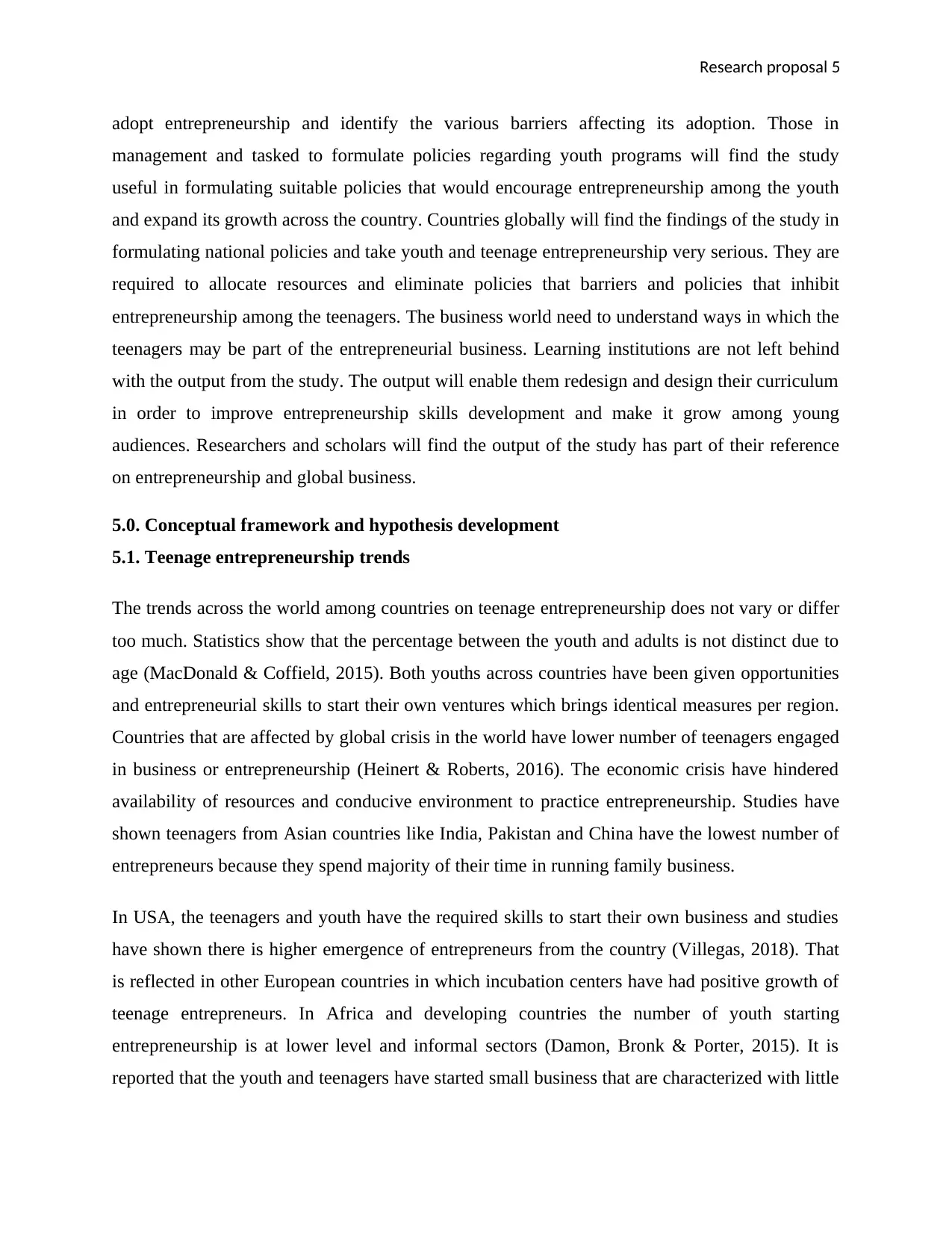
Research proposal 5
adopt entrepreneurship and identify the various barriers affecting its adoption. Those in
management and tasked to formulate policies regarding youth programs will find the study
useful in formulating suitable policies that would encourage entrepreneurship among the youth
and expand its growth across the country. Countries globally will find the findings of the study in
formulating national policies and take youth and teenage entrepreneurship very serious. They are
required to allocate resources and eliminate policies that barriers and policies that inhibit
entrepreneurship among the teenagers. The business world need to understand ways in which the
teenagers may be part of the entrepreneurial business. Learning institutions are not left behind
with the output from the study. The output will enable them redesign and design their curriculum
in order to improve entrepreneurship skills development and make it grow among young
audiences. Researchers and scholars will find the output of the study has part of their reference
on entrepreneurship and global business.
5.0. Conceptual framework and hypothesis development
5.1. Teenage entrepreneurship trends
The trends across the world among countries on teenage entrepreneurship does not vary or differ
too much. Statistics show that the percentage between the youth and adults is not distinct due to
age (MacDonald & Coffield, 2015). Both youths across countries have been given opportunities
and entrepreneurial skills to start their own ventures which brings identical measures per region.
Countries that are affected by global crisis in the world have lower number of teenagers engaged
in business or entrepreneurship (Heinert & Roberts, 2016). The economic crisis have hindered
availability of resources and conducive environment to practice entrepreneurship. Studies have
shown teenagers from Asian countries like India, Pakistan and China have the lowest number of
entrepreneurs because they spend majority of their time in running family business.
In USA, the teenagers and youth have the required skills to start their own business and studies
have shown there is higher emergence of entrepreneurs from the country (Villegas, 2018). That
is reflected in other European countries in which incubation centers have had positive growth of
teenage entrepreneurs. In Africa and developing countries the number of youth starting
entrepreneurship is at lower level and informal sectors (Damon, Bronk & Porter, 2015). It is
reported that the youth and teenagers have started small business that are characterized with little
adopt entrepreneurship and identify the various barriers affecting its adoption. Those in
management and tasked to formulate policies regarding youth programs will find the study
useful in formulating suitable policies that would encourage entrepreneurship among the youth
and expand its growth across the country. Countries globally will find the findings of the study in
formulating national policies and take youth and teenage entrepreneurship very serious. They are
required to allocate resources and eliminate policies that barriers and policies that inhibit
entrepreneurship among the teenagers. The business world need to understand ways in which the
teenagers may be part of the entrepreneurial business. Learning institutions are not left behind
with the output from the study. The output will enable them redesign and design their curriculum
in order to improve entrepreneurship skills development and make it grow among young
audiences. Researchers and scholars will find the output of the study has part of their reference
on entrepreneurship and global business.
5.0. Conceptual framework and hypothesis development
5.1. Teenage entrepreneurship trends
The trends across the world among countries on teenage entrepreneurship does not vary or differ
too much. Statistics show that the percentage between the youth and adults is not distinct due to
age (MacDonald & Coffield, 2015). Both youths across countries have been given opportunities
and entrepreneurial skills to start their own ventures which brings identical measures per region.
Countries that are affected by global crisis in the world have lower number of teenagers engaged
in business or entrepreneurship (Heinert & Roberts, 2016). The economic crisis have hindered
availability of resources and conducive environment to practice entrepreneurship. Studies have
shown teenagers from Asian countries like India, Pakistan and China have the lowest number of
entrepreneurs because they spend majority of their time in running family business.
In USA, the teenagers and youth have the required skills to start their own business and studies
have shown there is higher emergence of entrepreneurs from the country (Villegas, 2018). That
is reflected in other European countries in which incubation centers have had positive growth of
teenage entrepreneurs. In Africa and developing countries the number of youth starting
entrepreneurship is at lower level and informal sectors (Damon, Bronk & Porter, 2015). It is
reported that the youth and teenagers have started small business that are characterized with little
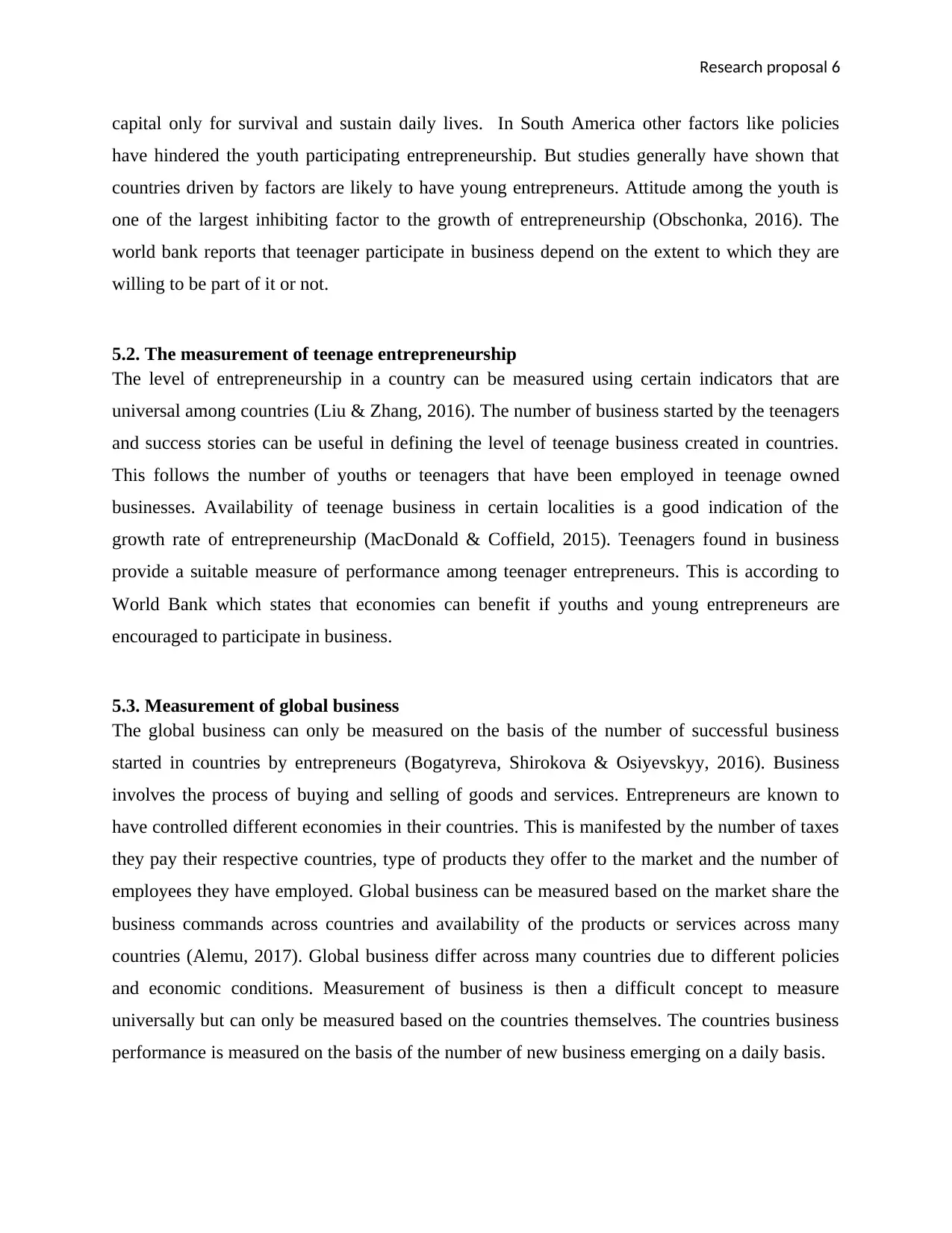
Research proposal 6
capital only for survival and sustain daily lives. In South America other factors like policies
have hindered the youth participating entrepreneurship. But studies generally have shown that
countries driven by factors are likely to have young entrepreneurs. Attitude among the youth is
one of the largest inhibiting factor to the growth of entrepreneurship (Obschonka, 2016). The
world bank reports that teenager participate in business depend on the extent to which they are
willing to be part of it or not.
5.2. The measurement of teenage entrepreneurship
The level of entrepreneurship in a country can be measured using certain indicators that are
universal among countries (Liu & Zhang, 2016). The number of business started by the teenagers
and success stories can be useful in defining the level of teenage business created in countries.
This follows the number of youths or teenagers that have been employed in teenage owned
businesses. Availability of teenage business in certain localities is a good indication of the
growth rate of entrepreneurship (MacDonald & Coffield, 2015). Teenagers found in business
provide a suitable measure of performance among teenager entrepreneurs. This is according to
World Bank which states that economies can benefit if youths and young entrepreneurs are
encouraged to participate in business.
5.3. Measurement of global business
The global business can only be measured on the basis of the number of successful business
started in countries by entrepreneurs (Bogatyreva, Shirokova & Osiyevskyy, 2016). Business
involves the process of buying and selling of goods and services. Entrepreneurs are known to
have controlled different economies in their countries. This is manifested by the number of taxes
they pay their respective countries, type of products they offer to the market and the number of
employees they have employed. Global business can be measured based on the market share the
business commands across countries and availability of the products or services across many
countries (Alemu, 2017). Global business differ across many countries due to different policies
and economic conditions. Measurement of business is then a difficult concept to measure
universally but can only be measured based on the countries themselves. The countries business
performance is measured on the basis of the number of new business emerging on a daily basis.
capital only for survival and sustain daily lives. In South America other factors like policies
have hindered the youth participating entrepreneurship. But studies generally have shown that
countries driven by factors are likely to have young entrepreneurs. Attitude among the youth is
one of the largest inhibiting factor to the growth of entrepreneurship (Obschonka, 2016). The
world bank reports that teenager participate in business depend on the extent to which they are
willing to be part of it or not.
5.2. The measurement of teenage entrepreneurship
The level of entrepreneurship in a country can be measured using certain indicators that are
universal among countries (Liu & Zhang, 2016). The number of business started by the teenagers
and success stories can be useful in defining the level of teenage business created in countries.
This follows the number of youths or teenagers that have been employed in teenage owned
businesses. Availability of teenage business in certain localities is a good indication of the
growth rate of entrepreneurship (MacDonald & Coffield, 2015). Teenagers found in business
provide a suitable measure of performance among teenager entrepreneurs. This is according to
World Bank which states that economies can benefit if youths and young entrepreneurs are
encouraged to participate in business.
5.3. Measurement of global business
The global business can only be measured on the basis of the number of successful business
started in countries by entrepreneurs (Bogatyreva, Shirokova & Osiyevskyy, 2016). Business
involves the process of buying and selling of goods and services. Entrepreneurs are known to
have controlled different economies in their countries. This is manifested by the number of taxes
they pay their respective countries, type of products they offer to the market and the number of
employees they have employed. Global business can be measured based on the market share the
business commands across countries and availability of the products or services across many
countries (Alemu, 2017). Global business differ across many countries due to different policies
and economic conditions. Measurement of business is then a difficult concept to measure
universally but can only be measured based on the countries themselves. The countries business
performance is measured on the basis of the number of new business emerging on a daily basis.
⊘ This is a preview!⊘
Do you want full access?
Subscribe today to unlock all pages.

Trusted by 1+ million students worldwide
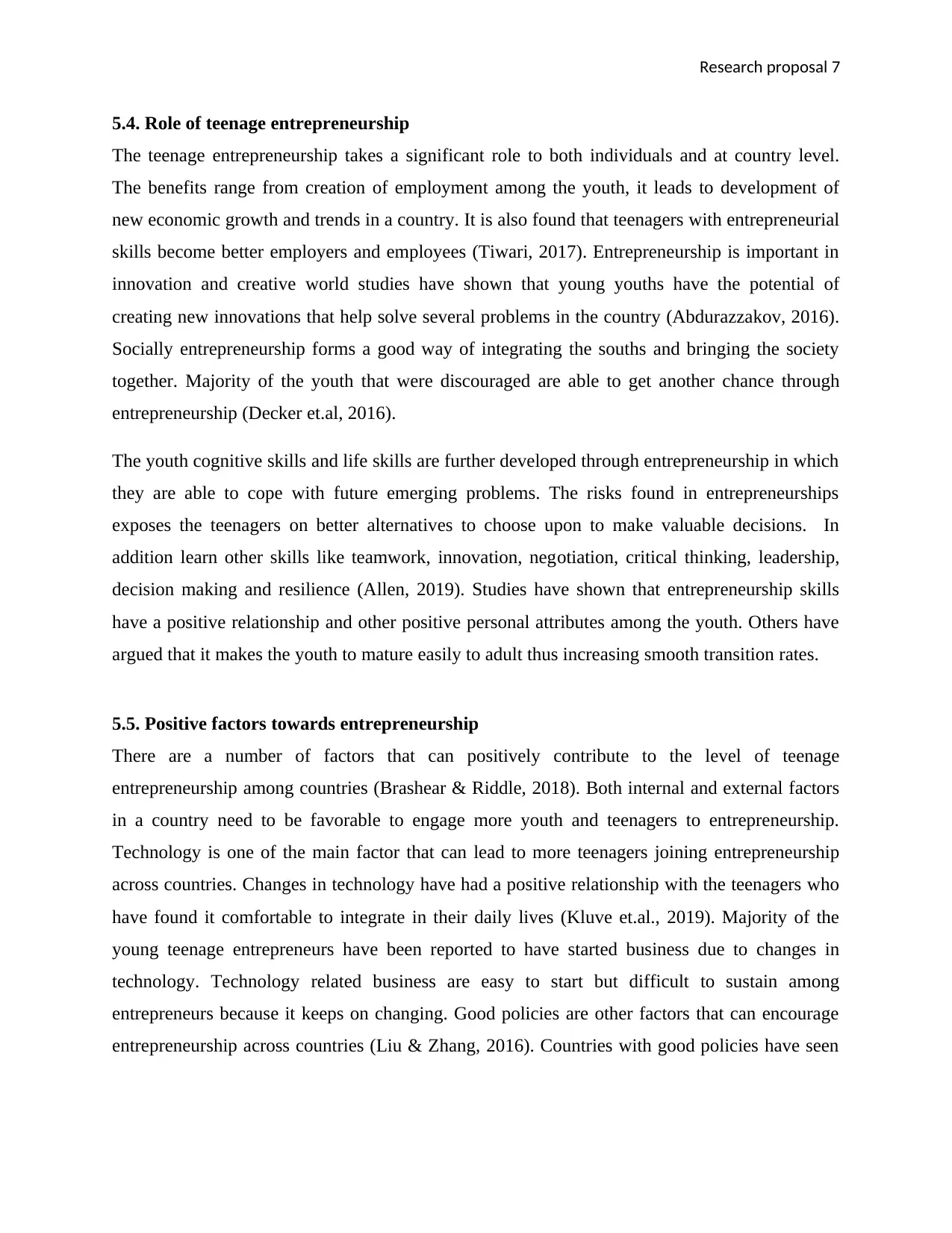
Research proposal 7
5.4. Role of teenage entrepreneurship
The teenage entrepreneurship takes a significant role to both individuals and at country level.
The benefits range from creation of employment among the youth, it leads to development of
new economic growth and trends in a country. It is also found that teenagers with entrepreneurial
skills become better employers and employees (Tiwari, 2017). Entrepreneurship is important in
innovation and creative world studies have shown that young youths have the potential of
creating new innovations that help solve several problems in the country (Abdurazzakov, 2016).
Socially entrepreneurship forms a good way of integrating the souths and bringing the society
together. Majority of the youth that were discouraged are able to get another chance through
entrepreneurship (Decker et.al, 2016).
The youth cognitive skills and life skills are further developed through entrepreneurship in which
they are able to cope with future emerging problems. The risks found in entrepreneurships
exposes the teenagers on better alternatives to choose upon to make valuable decisions. In
addition learn other skills like teamwork, innovation, negotiation, critical thinking, leadership,
decision making and resilience (Allen, 2019). Studies have shown that entrepreneurship skills
have a positive relationship and other positive personal attributes among the youth. Others have
argued that it makes the youth to mature easily to adult thus increasing smooth transition rates.
5.5. Positive factors towards entrepreneurship
There are a number of factors that can positively contribute to the level of teenage
entrepreneurship among countries (Brashear & Riddle, 2018). Both internal and external factors
in a country need to be favorable to engage more youth and teenagers to entrepreneurship.
Technology is one of the main factor that can lead to more teenagers joining entrepreneurship
across countries. Changes in technology have had a positive relationship with the teenagers who
have found it comfortable to integrate in their daily lives (Kluve et.al., 2019). Majority of the
young teenage entrepreneurs have been reported to have started business due to changes in
technology. Technology related business are easy to start but difficult to sustain among
entrepreneurs because it keeps on changing. Good policies are other factors that can encourage
entrepreneurship across countries (Liu & Zhang, 2016). Countries with good policies have seen
5.4. Role of teenage entrepreneurship
The teenage entrepreneurship takes a significant role to both individuals and at country level.
The benefits range from creation of employment among the youth, it leads to development of
new economic growth and trends in a country. It is also found that teenagers with entrepreneurial
skills become better employers and employees (Tiwari, 2017). Entrepreneurship is important in
innovation and creative world studies have shown that young youths have the potential of
creating new innovations that help solve several problems in the country (Abdurazzakov, 2016).
Socially entrepreneurship forms a good way of integrating the souths and bringing the society
together. Majority of the youth that were discouraged are able to get another chance through
entrepreneurship (Decker et.al, 2016).
The youth cognitive skills and life skills are further developed through entrepreneurship in which
they are able to cope with future emerging problems. The risks found in entrepreneurships
exposes the teenagers on better alternatives to choose upon to make valuable decisions. In
addition learn other skills like teamwork, innovation, negotiation, critical thinking, leadership,
decision making and resilience (Allen, 2019). Studies have shown that entrepreneurship skills
have a positive relationship and other positive personal attributes among the youth. Others have
argued that it makes the youth to mature easily to adult thus increasing smooth transition rates.
5.5. Positive factors towards entrepreneurship
There are a number of factors that can positively contribute to the level of teenage
entrepreneurship among countries (Brashear & Riddle, 2018). Both internal and external factors
in a country need to be favorable to engage more youth and teenagers to entrepreneurship.
Technology is one of the main factor that can lead to more teenagers joining entrepreneurship
across countries. Changes in technology have had a positive relationship with the teenagers who
have found it comfortable to integrate in their daily lives (Kluve et.al., 2019). Majority of the
young teenage entrepreneurs have been reported to have started business due to changes in
technology. Technology related business are easy to start but difficult to sustain among
entrepreneurs because it keeps on changing. Good policies are other factors that can encourage
entrepreneurship across countries (Liu & Zhang, 2016). Countries with good policies have seen
Paraphrase This Document
Need a fresh take? Get an instant paraphrase of this document with our AI Paraphraser
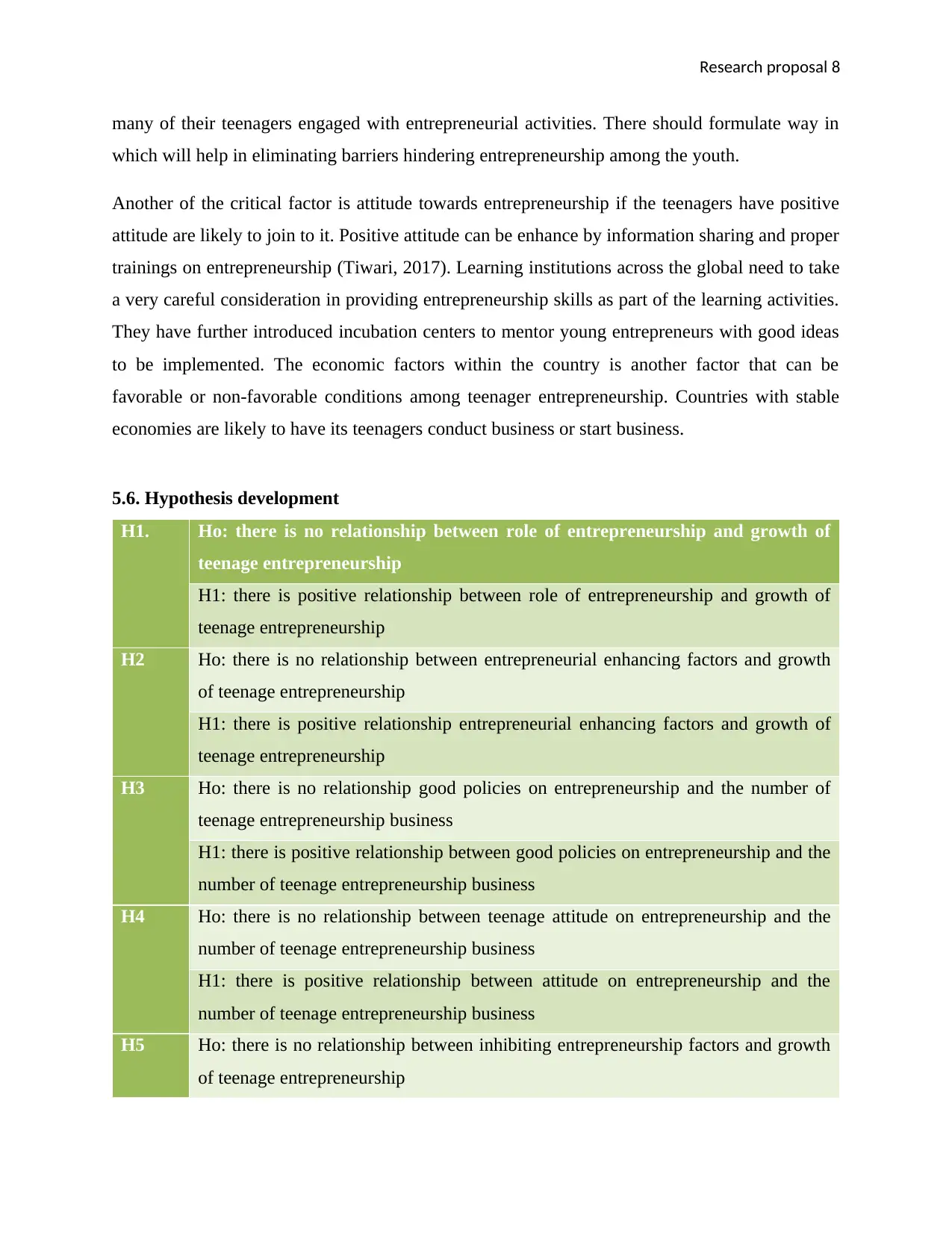
Research proposal 8
many of their teenagers engaged with entrepreneurial activities. There should formulate way in
which will help in eliminating barriers hindering entrepreneurship among the youth.
Another of the critical factor is attitude towards entrepreneurship if the teenagers have positive
attitude are likely to join to it. Positive attitude can be enhance by information sharing and proper
trainings on entrepreneurship (Tiwari, 2017). Learning institutions across the global need to take
a very careful consideration in providing entrepreneurship skills as part of the learning activities.
They have further introduced incubation centers to mentor young entrepreneurs with good ideas
to be implemented. The economic factors within the country is another factor that can be
favorable or non-favorable conditions among teenager entrepreneurship. Countries with stable
economies are likely to have its teenagers conduct business or start business.
5.6. Hypothesis development
H1. Ho: there is no relationship between role of entrepreneurship and growth of
teenage entrepreneurship
H1: there is positive relationship between role of entrepreneurship and growth of
teenage entrepreneurship
H2 Ho: there is no relationship between entrepreneurial enhancing factors and growth
of teenage entrepreneurship
H1: there is positive relationship entrepreneurial enhancing factors and growth of
teenage entrepreneurship
H3 Ho: there is no relationship good policies on entrepreneurship and the number of
teenage entrepreneurship business
H1: there is positive relationship between good policies on entrepreneurship and the
number of teenage entrepreneurship business
H4 Ho: there is no relationship between teenage attitude on entrepreneurship and the
number of teenage entrepreneurship business
H1: there is positive relationship between attitude on entrepreneurship and the
number of teenage entrepreneurship business
H5 Ho: there is no relationship between inhibiting entrepreneurship factors and growth
of teenage entrepreneurship
many of their teenagers engaged with entrepreneurial activities. There should formulate way in
which will help in eliminating barriers hindering entrepreneurship among the youth.
Another of the critical factor is attitude towards entrepreneurship if the teenagers have positive
attitude are likely to join to it. Positive attitude can be enhance by information sharing and proper
trainings on entrepreneurship (Tiwari, 2017). Learning institutions across the global need to take
a very careful consideration in providing entrepreneurship skills as part of the learning activities.
They have further introduced incubation centers to mentor young entrepreneurs with good ideas
to be implemented. The economic factors within the country is another factor that can be
favorable or non-favorable conditions among teenager entrepreneurship. Countries with stable
economies are likely to have its teenagers conduct business or start business.
5.6. Hypothesis development
H1. Ho: there is no relationship between role of entrepreneurship and growth of
teenage entrepreneurship
H1: there is positive relationship between role of entrepreneurship and growth of
teenage entrepreneurship
H2 Ho: there is no relationship between entrepreneurial enhancing factors and growth
of teenage entrepreneurship
H1: there is positive relationship entrepreneurial enhancing factors and growth of
teenage entrepreneurship
H3 Ho: there is no relationship good policies on entrepreneurship and the number of
teenage entrepreneurship business
H1: there is positive relationship between good policies on entrepreneurship and the
number of teenage entrepreneurship business
H4 Ho: there is no relationship between teenage attitude on entrepreneurship and the
number of teenage entrepreneurship business
H1: there is positive relationship between attitude on entrepreneurship and the
number of teenage entrepreneurship business
H5 Ho: there is no relationship between inhibiting entrepreneurship factors and growth
of teenage entrepreneurship
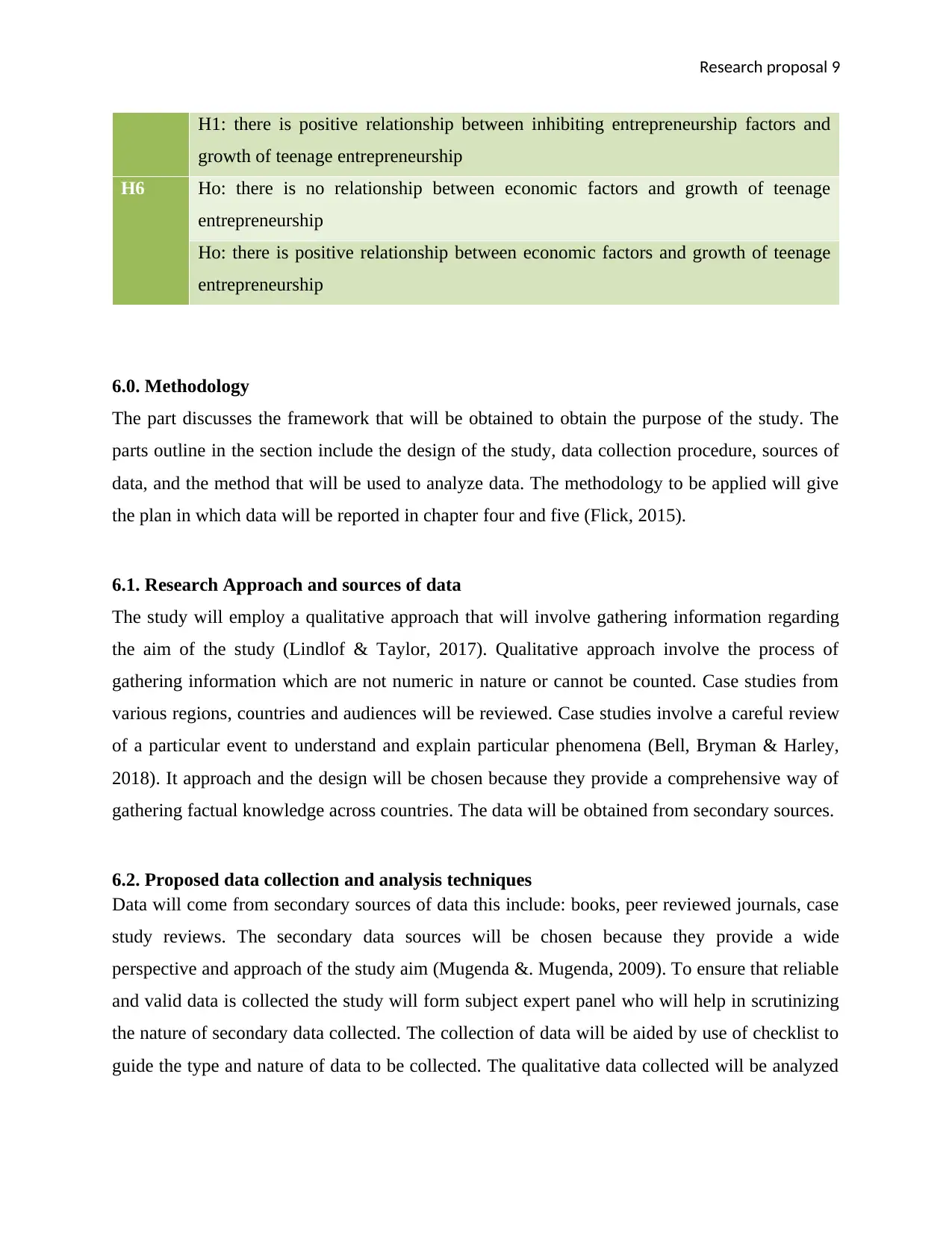
Research proposal 9
H1: there is positive relationship between inhibiting entrepreneurship factors and
growth of teenage entrepreneurship
H6 Ho: there is no relationship between economic factors and growth of teenage
entrepreneurship
Ho: there is positive relationship between economic factors and growth of teenage
entrepreneurship
6.0. Methodology
The part discusses the framework that will be obtained to obtain the purpose of the study. The
parts outline in the section include the design of the study, data collection procedure, sources of
data, and the method that will be used to analyze data. The methodology to be applied will give
the plan in which data will be reported in chapter four and five (Flick, 2015).
6.1. Research Approach and sources of data
The study will employ a qualitative approach that will involve gathering information regarding
the aim of the study (Lindlof & Taylor, 2017). Qualitative approach involve the process of
gathering information which are not numeric in nature or cannot be counted. Case studies from
various regions, countries and audiences will be reviewed. Case studies involve a careful review
of a particular event to understand and explain particular phenomena (Bell, Bryman & Harley,
2018). It approach and the design will be chosen because they provide a comprehensive way of
gathering factual knowledge across countries. The data will be obtained from secondary sources.
6.2. Proposed data collection and analysis techniques
Data will come from secondary sources of data this include: books, peer reviewed journals, case
study reviews. The secondary data sources will be chosen because they provide a wide
perspective and approach of the study aim (Mugenda &. Mugenda, 2009). To ensure that reliable
and valid data is collected the study will form subject expert panel who will help in scrutinizing
the nature of secondary data collected. The collection of data will be aided by use of checklist to
guide the type and nature of data to be collected. The qualitative data collected will be analyzed
H1: there is positive relationship between inhibiting entrepreneurship factors and
growth of teenage entrepreneurship
H6 Ho: there is no relationship between economic factors and growth of teenage
entrepreneurship
Ho: there is positive relationship between economic factors and growth of teenage
entrepreneurship
6.0. Methodology
The part discusses the framework that will be obtained to obtain the purpose of the study. The
parts outline in the section include the design of the study, data collection procedure, sources of
data, and the method that will be used to analyze data. The methodology to be applied will give
the plan in which data will be reported in chapter four and five (Flick, 2015).
6.1. Research Approach and sources of data
The study will employ a qualitative approach that will involve gathering information regarding
the aim of the study (Lindlof & Taylor, 2017). Qualitative approach involve the process of
gathering information which are not numeric in nature or cannot be counted. Case studies from
various regions, countries and audiences will be reviewed. Case studies involve a careful review
of a particular event to understand and explain particular phenomena (Bell, Bryman & Harley,
2018). It approach and the design will be chosen because they provide a comprehensive way of
gathering factual knowledge across countries. The data will be obtained from secondary sources.
6.2. Proposed data collection and analysis techniques
Data will come from secondary sources of data this include: books, peer reviewed journals, case
study reviews. The secondary data sources will be chosen because they provide a wide
perspective and approach of the study aim (Mugenda &. Mugenda, 2009). To ensure that reliable
and valid data is collected the study will form subject expert panel who will help in scrutinizing
the nature of secondary data collected. The collection of data will be aided by use of checklist to
guide the type and nature of data to be collected. The qualitative data collected will be analyzed
⊘ This is a preview!⊘
Do you want full access?
Subscribe today to unlock all pages.

Trusted by 1+ million students worldwide
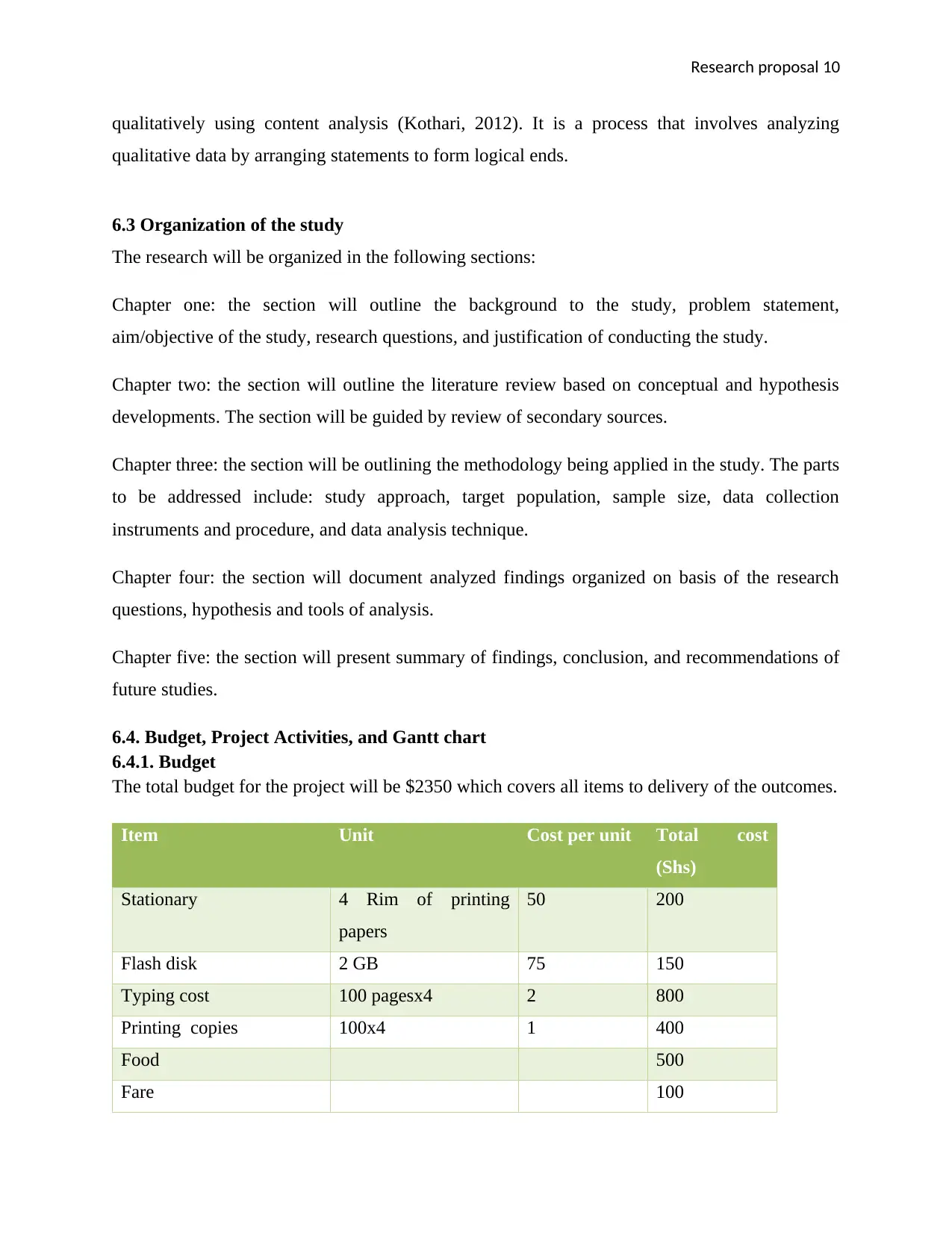
Research proposal 10
qualitatively using content analysis (Kothari, 2012). It is a process that involves analyzing
qualitative data by arranging statements to form logical ends.
6.3 Organization of the study
The research will be organized in the following sections:
Chapter one: the section will outline the background to the study, problem statement,
aim/objective of the study, research questions, and justification of conducting the study.
Chapter two: the section will outline the literature review based on conceptual and hypothesis
developments. The section will be guided by review of secondary sources.
Chapter three: the section will be outlining the methodology being applied in the study. The parts
to be addressed include: study approach, target population, sample size, data collection
instruments and procedure, and data analysis technique.
Chapter four: the section will document analyzed findings organized on basis of the research
questions, hypothesis and tools of analysis.
Chapter five: the section will present summary of findings, conclusion, and recommendations of
future studies.
6.4. Budget, Project Activities, and Gantt chart
6.4.1. Budget
The total budget for the project will be $2350 which covers all items to delivery of the outcomes.
Item Unit Cost per unit Total cost
(Shs)
Stationary 4 Rim of printing
papers
50 200
Flash disk 2 GB 75 150
Typing cost 100 pagesx4 2 800
Printing copies 100x4 1 400
Food 500
Fare 100
qualitatively using content analysis (Kothari, 2012). It is a process that involves analyzing
qualitative data by arranging statements to form logical ends.
6.3 Organization of the study
The research will be organized in the following sections:
Chapter one: the section will outline the background to the study, problem statement,
aim/objective of the study, research questions, and justification of conducting the study.
Chapter two: the section will outline the literature review based on conceptual and hypothesis
developments. The section will be guided by review of secondary sources.
Chapter three: the section will be outlining the methodology being applied in the study. The parts
to be addressed include: study approach, target population, sample size, data collection
instruments and procedure, and data analysis technique.
Chapter four: the section will document analyzed findings organized on basis of the research
questions, hypothesis and tools of analysis.
Chapter five: the section will present summary of findings, conclusion, and recommendations of
future studies.
6.4. Budget, Project Activities, and Gantt chart
6.4.1. Budget
The total budget for the project will be $2350 which covers all items to delivery of the outcomes.
Item Unit Cost per unit Total cost
(Shs)
Stationary 4 Rim of printing
papers
50 200
Flash disk 2 GB 75 150
Typing cost 100 pagesx4 2 800
Printing copies 100x4 1 400
Food 500
Fare 100
Paraphrase This Document
Need a fresh take? Get an instant paraphrase of this document with our AI Paraphraser

Research proposal 11
Research analyst/assist 3 50 150
Miscellaneous 50
Total 2,350
Research analyst/assist 3 50 150
Miscellaneous 50
Total 2,350
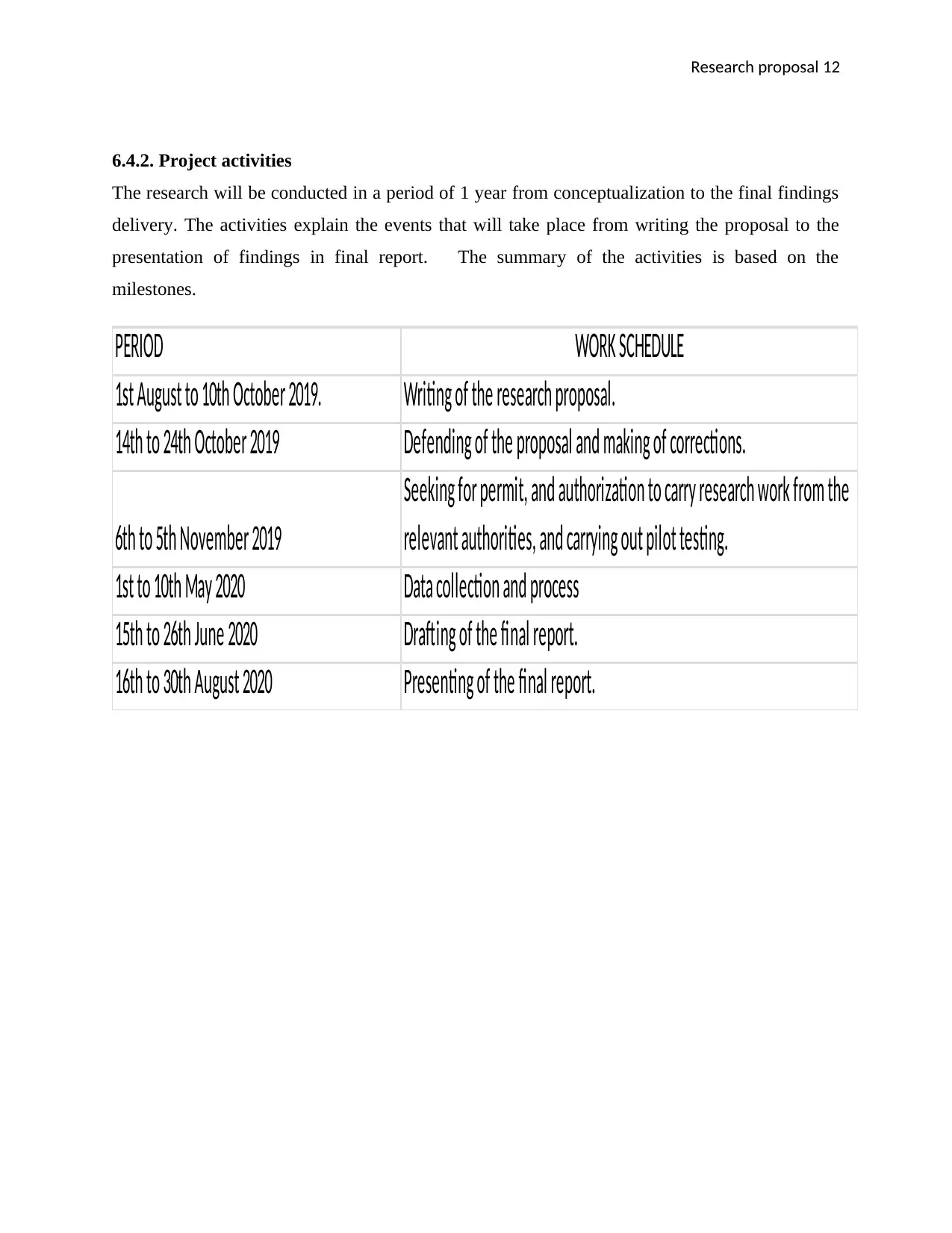
Research proposal 12
6.4.2. Project activities
The research will be conducted in a period of 1 year from conceptualization to the final findings
delivery. The activities explain the events that will take place from writing the proposal to the
presentation of findings in final report. The summary of the activities is based on the
milestones.
PERIOD WORK SCHEDULE
1st August to 10th October 2019. Writing of the research proposal.
14th to 24th October 2019 Defending of the proposal and making of corrections.
6th to 5th November 2019
Seeking for permit, and authorization to carry research work from the
relevant authorities, and carrying out pilot testing.
1st to 10th May 2020 Data collection and process
15th to 26th June 2020 Drafting of the final report.
16th to 30th August 2020 Presenting of the final report.
6.4.2. Project activities
The research will be conducted in a period of 1 year from conceptualization to the final findings
delivery. The activities explain the events that will take place from writing the proposal to the
presentation of findings in final report. The summary of the activities is based on the
milestones.
PERIOD WORK SCHEDULE
1st August to 10th October 2019. Writing of the research proposal.
14th to 24th October 2019 Defending of the proposal and making of corrections.
6th to 5th November 2019
Seeking for permit, and authorization to carry research work from the
relevant authorities, and carrying out pilot testing.
1st to 10th May 2020 Data collection and process
15th to 26th June 2020 Drafting of the final report.
16th to 30th August 2020 Presenting of the final report.
⊘ This is a preview!⊘
Do you want full access?
Subscribe today to unlock all pages.

Trusted by 1+ million students worldwide
1 out of 16
Related Documents
Your All-in-One AI-Powered Toolkit for Academic Success.
+13062052269
info@desklib.com
Available 24*7 on WhatsApp / Email
![[object Object]](/_next/static/media/star-bottom.7253800d.svg)
Unlock your academic potential
Copyright © 2020–2025 A2Z Services. All Rights Reserved. Developed and managed by ZUCOL.


